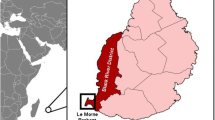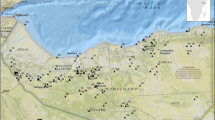Abstract
The Swahili people have been viewed as of Persian/Arabic or Cushitic-speaking origin. Scholars have used historical and archaeological data to support this hypothesis. However, linguistic and recent archaeological data suggest that the Swahili culture had its origin in the early first centuries AD. It was the early farming people who settled on the coast in the last centuries BC who first adopted iron technology and sailing techniques and founded the coastal settlements. The culture of the iron-using people spread to the rest of the coast of East Africa, its center changing from one place to another. Involvement in transoceanic trade from the early centuries AD contributed to the prosperity of the coastal communities as evidenced by coastal monuments. More than 1500 years of cultural continuity was offset by the arrival of European and Arab colonizers in the seventeenth and nineteenth centuries AD.
Le peuple Swahili a souvent été consideré comme un peuple dont la langue avait pour origine le Perse/Arabe ou le Cushite. Les chercheurs ont utilisé des donées historiques et archéologiques afin de supporter cette hypothese. Cependant l'étude linguistique de cette langue, ainsi que de nouvelles découvertes archéologiques suggérent que la culture Swahili trouve son origine au début de l'ère chrétienne. Ils furent les premiers fermiers à s'installer le long du littoral, fondant des villages côtiers, vers les premiers siécles de notre ère, les premiers aussi à adopter les techniques du fer et les techniques de navigation. La culture du fer s'étendit rapidement au reste des côtes d'Afrique de l'Est, son centre se déplaçant d'un endroit à un autre. Leur implication dans le commerce océanique contrbua à la prosperité de leur communautés côtières, mise en évidence notamment par les monuments le long du littoral. Plus de 1500 ans de continuité culturelle pris fin à l'arrivé des colonisateurs Européens et Arabes de dixseptième et dixhuitième siècles.
Similar content being viewed by others
REFERENCES
Abungu, G. (1989). Communities on the River Tana, Kenya: An Archaeological Study of Relations Between the Delta and River Basin 700-1800 AD, Ph.D. thesis, Cambridge University, Cambridge.
Abungu, G. (1994-1995). Agriculture and settlement formation along the East African coast. Azania 29-30: 248–256.
Allen, J. de V. (1977). Settlement patterns on the East African coast, c. AD 800-1900. In Leakey, R. E. and Ogot, B. A. (eds.), Proceedings of the 8th Panafrican Congress of Prehistory and Quaternary Studies Nairobi, The International Louis Leakey Memorial Institute for African Prehistory, Nairobi, pp. 361–363.
Allen, J. de V. (1982). The “Shirazi” problem in East African coastal history. Paideuma 28: 9–28.
Allen, J. de V. (1993). Swahili Origins, James Curry, London.
Chami, F. A. (1992). Limbo: Early iron-working in south-eastern Tanzania. Azania 27: 45–52.
Chami, F. A. (1994). The Tanzanian Coast in the First Millennium AD, Uppsaliensis SAA 7, Uppsala.
Chami, F. A. (1994–1995). The first millennium AD on the East Coast: A new look at the cultural sequence and interactions. Azania 29-30: 232–37.
Chami, F. A. (1996). The excavation of Kiwangwa Last Stone Age site. In Pwiti, G., and Soper, R. (eds.), Aspects of African Archaeology, University of Zimbabwe, Harare, pp. 307–316.
Chami, F. A. (1998). The ancient cultural sequences for the central coast of East Africa: New perspective. In Sinclair, P., Mutoro, H., and Abungu, G. (eds.), Aspects of Urbanism, Papers from the World Archaeological Congress on “Urban Origins in East Africa” held in Mombassa, 1993 (in press).
Chami, F., and Kessy, E. (1995). Archaeological work at Kisiju, Tanzania, 1994. Nyame Akuma 43: 38–45.
Chami, F., and Mapunda, B. (1998). The 1996 archaeological reconnaissance north of the Rufiji Delta. Nyame Akuma 49 (in press).
Chami, F., and Msemwa, P. (1997a). A new look at culture and trade on the Azanian coast. Current Anthropology 38(4): 673–677.
Chami, F. A., and Msemwa, P. (1997b). The excavation and Kwale island, south of Dar-es-Salaam. Nyame Akuma 48: 45–56.
Chittick, N. (1961). Kisimani Mafia: Excavations at an Island settlement on the East African coast. Antiquities Division Occasional Paper 1, Dar-es-Salaam.
Chittick, N. (1974). Kilwa: An Islamic Trading City on the East African coast (2 vols.), The Finds, British Institute in Eastern Africa, Nairobi.
Chittick, N. (1975). The peopling of the East Africa coast. In Chick, N., and Rotberg, R. (eds.), East Africa and the Orient: Cultural Syntheses in Pre-Colonial Times, Africana, New York, pp. 16–43.
Chittick, N. (1984). Manda: Excavations at an Island Port on the Kenya Coast (Memoir 9), British Institute in Eastern Africa, Nairobi.
Coupland, R. (1956). East Africa and Its Invaders, Clarendon Press, Oxford.
Cruz e Silva, T. (1977). First indication of Early Iron Age in southern Mozambique: MatolaIV 1/68. In Leakey, R. E., and Ogot, B. A. (eds.), Proceedings of the 8th Panafrican Congress of Prehistory and Quaternary Studies, International Louis Leakey Memorial Institute for African Prehistory, Nairobi, p. 349.
Duarte, R. T. (1993). Northern Mozambique in the Swahili World, Edwardo Mondlane University, Maputo.
Freeman-Grenville, G. (1962). The East African Coast: Select Documents from the First to the Earlier Nineteenth Century, Clarendon Press, Oxford.
Freeman-Grenville, G. (1963). The coast, 1498–1840. In Oliver, R., and Mathew, G. (eds.), History of East Africa, Clarendon Press, Oxford, pp. 129–168.
Gibb, A. (1939). Ibn Battuta Travels in Asia and Africa, George Routledge and Sons, London.
Haaland, R. (1994–1995). Dakawa: An early iron age site in the Tanzanian hinterland. Azania 29-30: 238–247.
Hodges, R., and Whitehouse, D. (1983). Mohammed, Charlemagne and the Origins of Europe, Cornell University Press, New York.
Horton, M. (1984). The Early Settlements of the Northern Swahili Coast, Ph.D. thesis, Cambridge University, Cambridge.
Horton, M. (1987). Early Muslim trading settlements on the East African coast: New evidence from Shanga. Antiquaries Journal 67: 290–322.
Horton, M. (1990). The Periplus and East Africa. Azania 25: 95–9.
Horton, M. (1996). Shanga: The Archaeology of a Muslim Trading Community on the coast of East Africa, British Institute in Eastern Africa, London.
Hollingsworth, L. (1951). A Short History of the East Coast of Africa, Macmillan, London.
Juma, A. (1996). The Swahili and the Mediterranean worlds: Pottery of the late Roman period from Zanzibar. Antiquity 70: 148–154.
Kiriama, H., Mutoro, H., and Ngari, L. (1996). Iron working in the upper Tana valley, Kenya. In Pwiti, G., and Soper, R. (eds.), Aspects of African Archaeology, University of Zimbabwe, Harare, pp. 505–507.
Kirkman, F. (1964). Men and Monuments on the East African Coast, Lutterworth Press, London.
LaViolette, A., and Fleisher, J. (1995). Reconnaissance of sites bearing Triangular Incised (Tana Tradition) Ware on Pemba island, Tanzania. Nyame Akuma 44: 59–65.
Mathew, G. (1963), The East African coast until the coming of the Portuguese. In Oliver, R., and Mathew, G. (eds.), History of East Africa, Clarendon Press, Oxford, pp. 94–128.
Nicholls, C. (1971). The Swahili Coast, George Allen and Unwin, London.
Nurse, D., and Spear, T. (1985). The Swahili, University of Pennsylvania Press, Philadelphia.
Oliver, R. (1966). The problem of the Bantu expansion. Journal of African History 7: 361–76.
Phillipson, D. (1979). Some iron age sites in the lower Tana valley. Azania 14: 155–60.
Phillipson, D. (1993). African Archaeology, Cambridge University Press, Cambridge.
Radimilahy, S. (1998). Mahilaka: An Archaeological Investigation of an Early Town in North-Western Madagascar, Uppsaliensis, Uppsala (in press).
Robertshaw, P. (1990). Early Pastoralists of South-western Kenya, British Institute in Eastern Africa, Nairobi.
Schmidt, P. (1994-1995). The agricultural hinterland and settlement in Tanzania. Azania 29-30: 261–262.
Schmidt, P., Karoma, J., LaViolette, A., Fawcett, A., Mabulla, L., Rutabanzibwa, L., and Saanane, C. M. (1992). Archaeological Investigations in the Vicinity of Mkiu, Kisarawe District, Tanzania, University of Dar-es-Salaam, Dar-es-Salaam.
Sinclair, P. (1982). Chibuene: An early trading site in southern Mozambique. Paideuma 28: 149–64.
Sinclair, P. (1987). Space, Time, Social Formation: A Territorial Approach to the Archaeology and Anthropology of Zimbabwe and Mozambique, ca. 0-1700 AD, Uppsaliensis, Uppsala.
Sinclair, P. J., Morais, J., Adamowicz, L., and Duarte, L. (1993). A perspective on archaeological research in Mozambique. In Shaw, T., Sinclair, P., Andah, B., and Okpoko, A (eds.), The Archaeology of Africa: Food, Metals and Towns, Routledge, London, pp. 1–31.
Soper, R. (1967a). Kwale: An Early Iron Age site in south-eastern Kenya. Azania 2: 1–17.
Soper, R. (1967b). Iron Age in north-eastern Tanzania. Azania 2: 19–37.
Soper, R. (1971). A general review of Early Iron Age of the southern half of Africa. Azania 5: 5–37.
Sutton, J. (1990). A Thousand Years of East Africa, British Institute in Eastern Africa, Nairobi.
Sutton, J. (1994–195). East Africa: Interior and coast. Azania 29-30: 227–2-31.
Trimingham, J. (1975). The Arab geographers and the East African coast. In Chittick, N., and Rotberg, R. (eds.), East Africa and the Orient, Africana, New York, pp. 115–146.
Wilson, T. (1982). Spatial analysis and settlement patterns on the East African Coast. Paideuma 28: 201–219.
Wilson, T., and Omar, L. (1996). Excavation at Pate on the East African coast. In Pwiti, G., and Soper R. (eds.), Aspects of African Archaeology, University of Zimbabwe, Harare, pp. 543–554.
Wright, H. (1984). Early seafarers of the Comore islands: The Dembeni phase of the ixth-xth centuries AD. Azania 19: 13–60.
Author information
Authors and Affiliations
Rights and permissions
About this article
Cite this article
Chami, F.A. A Review of Swahili Archaeology. African Archaeological Review 15, 199–218 (1998). https://doi.org/10.1023/A:1021612012892
Issue Date:
DOI: https://doi.org/10.1023/A:1021612012892




